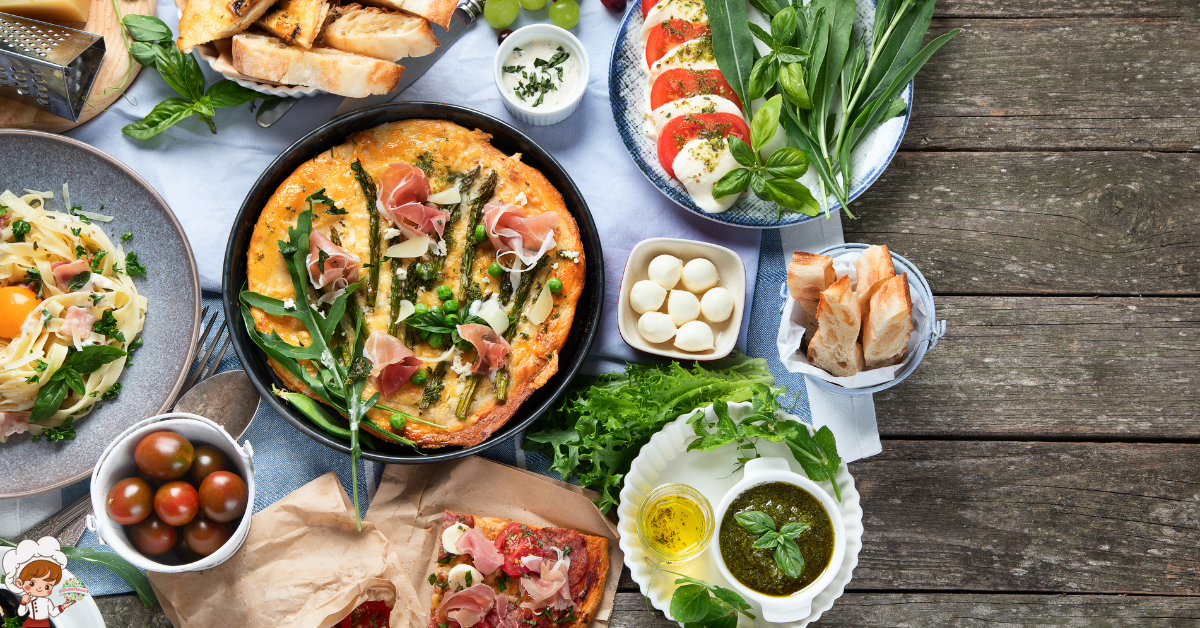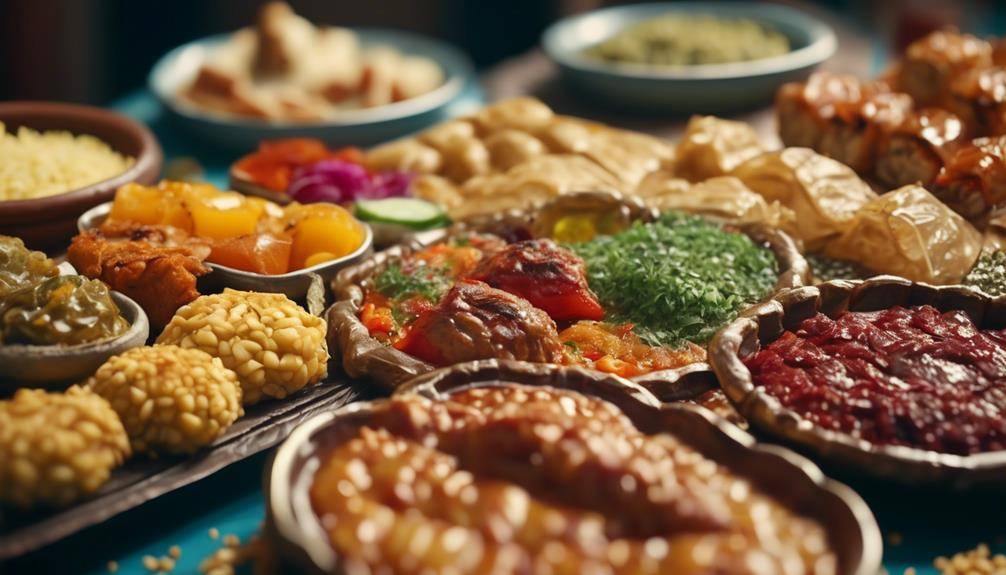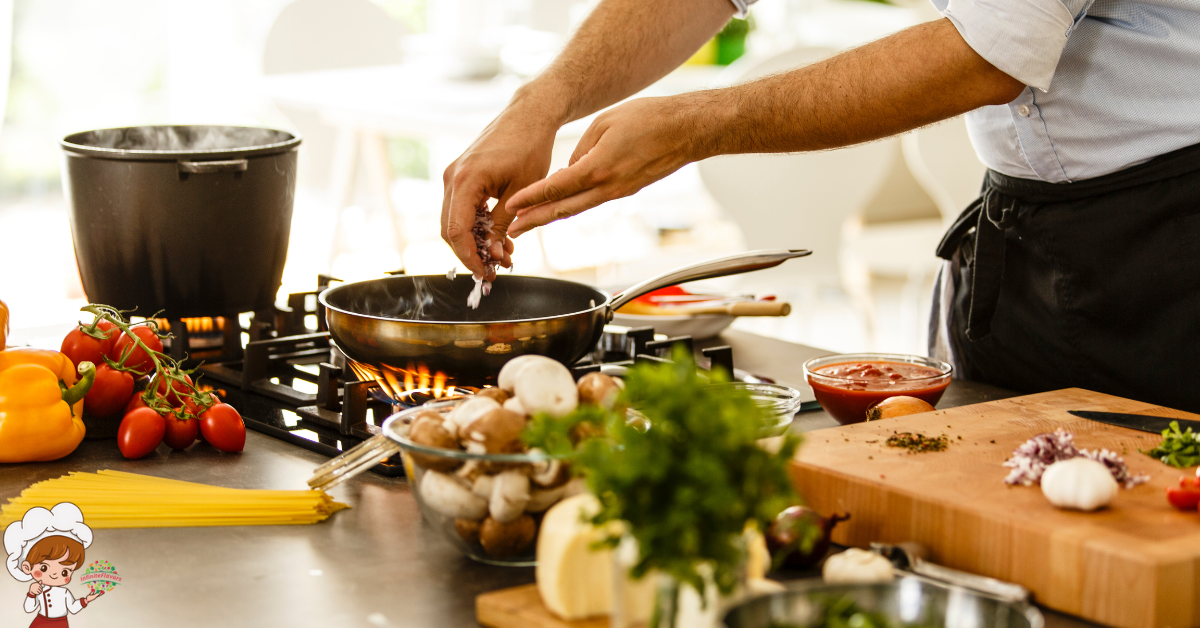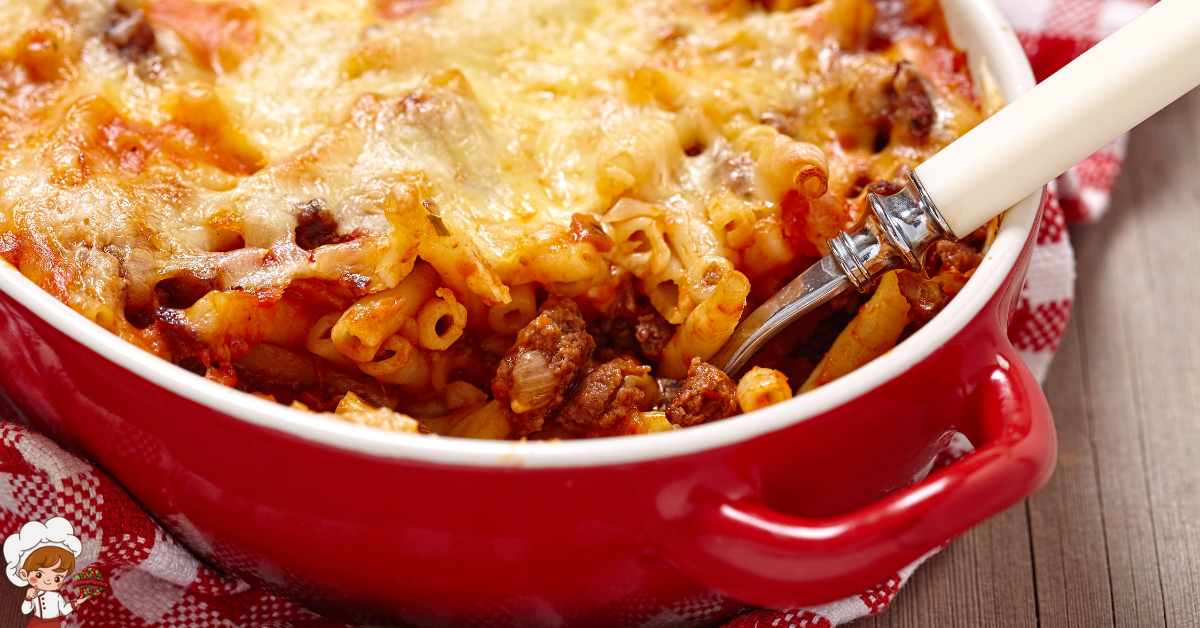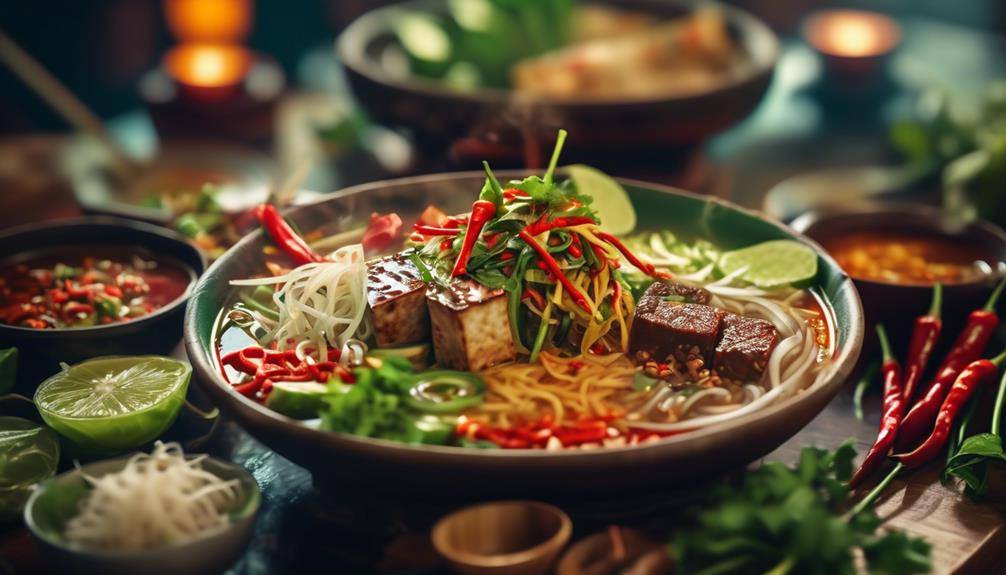The Best Classic French Dishes

Step into a culinary time machine and embark on a journey to the land of The Best Classic French Dishes. From the elegant Escargots De Bourgogne to the hearty Coq Au Vin, these timeless creations have stood the test of time, tantalizing taste buds with their exquisite flavors and meticulous preparation. But what makes these dishes so special? What secrets lie beneath their perfectly crafted layers? Join us as we unravel the mysteries of these iconic French delicacies, exploring their rich history, cultural significance, and the artistry that goes into creating them. Get ready to savor the essence of French cuisine like never before.
Escargots De Bourgogne
Escargots De Bourgogne, a classic French dish, are made with tender snails cooked in a flavorful garlic and herb butter sauce. This traditional French cuisine holds great cultural significance in the country’s culinary history. The consumption of snails dates back to ancient times and has been a part of French gastronomy for centuries.
The origins of escargots can be traced back to the Roman Empire, where snails were considered a delicacy. However, it was during the medieval period that the French began to develop a taste for these slimy creatures. Escargots were readily available in the Burgundy region, where they thrived in the vineyards. It was here that the dish, Escargots De Bourgogne, was born.
The cultural significance of escargots lies in its connection to French tradition and the appreciation of local ingredients. The meticulous process of preparing and cooking escargots showcases the French dedication to culinary excellence. The snails are carefully purged, cleaned, and then cooked in a rich butter sauce infused with garlic and herbs such as parsley and thyme. The flavors of the sauce complement the earthy taste of the snails, creating a harmonious combination.
Escargots De Bourgogne has become synonymous with French cuisine, representing the country’s commitment to preserving culinary traditions. It is often served as an appetizer, accompanied by crusty bread to soak up the delicious sauce. The dish is not only enjoyed for its unique taste but also for the cultural experience it offers. So, the next time you find yourself in France, be sure to try Escargots De Bourgogne and savor the flavors that have stood the test of time.
Coq Au Vin
Coq Au Vin, a classic French dish, is a flavorful and hearty poultry stew that has deep historical roots in French cuisine. This dish showcases the artistry of French cooking techniques and the importance of wine pairing in French gastronomy.
The name “Coq Au Vin” translates to “rooster with wine,” which reflects the traditional use of an older rooster in the preparation of this dish. The tough meat of the rooster is braised slowly in red wine, creating a rich and tender stew. This cooking technique allows the flavors to meld together, resulting in a dish that is savory, aromatic, and deeply satisfying.
The choice of wine used in Coq Au Vin is crucial to its success. Traditionally, a Burgundy wine is used, as it complements the robust flavors of the dish. The wine not only adds depth and complexity but also helps to tenderize the meat. The flavors of the wine infuse the stew, creating a harmonious marriage of flavors that is a hallmark of French cuisine.
Coq Au Vin has a long history, dating back to medieval times when it was a popular dish among the French aristocracy. Over the years, it has become a staple in French households and a symbol of French culinary excellence. Today, it is enjoyed by people all over the world, who appreciate its rustic charm and the skill required to prepare it.
Whether you are a seasoned cook or a novice in the kitchen, Coq Au Vin is a dish that will impress. Its rich flavors, tender meat, and the delicate balance of wine make it a true masterpiece of French gastronomy. So, grab a bottle of Burgundy wine, gather your ingredients, and embark on a culinary journey to savor the timeless flavors of Coq Au Vin.
Bouillabaisse
The next classic French dish that we will explore is Bouillabaisse, a flavorful seafood stew that has its own unique place in the rich culinary tradition of France. Bouillabaisse originated in the port city of Marseille, where fishermen would make this hearty dish using the catch of the day. Here are four things you need to know about Bouillabaisse:
- Cooking Techniques: Bouillabaisse is traditionally made by slowly simmering a combination of different types of fish, such as rockfish, monkfish, and mullet, along with shellfish like mussels and clams. The fish and shellfish are cooked in a fragrant broth made with tomatoes, onions, garlic, saffron, and various herbs and spices. The key to a perfect Bouillabaisse is to cook the ingredients just long enough to infuse the flavors, without overcooking the seafood.
- Regional Variations: While Bouillabaisse is most closely associated with Marseille, there are regional variations of this dish throughout France. In Nice, for example, they have their own version called “Bouillabaisse Niçoise,” which includes additional ingredients like potatoes and vegetables. In other regions, the types of fish and shellfish used may vary depending on what is locally available.
- Historical Significance: Bouillabaisse has a long history that dates back to ancient times. The dish was originally created by Mediterranean fishermen who needed a way to use the less desirable fish that they couldn’t sell. Over time, Bouillabaisse evolved into a beloved dish that symbolizes the cultural and culinary heritage of the region.
- Serving Traditions: Bouillabaisse is traditionally served in two courses. First, the flavorful broth is served with slices of toasted bread and a garlic-infused rouille sauce. Then, the cooked fish and shellfish are presented separately on a platter for diners to enjoy. This two-step serving method allows the flavors of the broth and seafood to be savored individually.
Bouillabaisse is not only a delicious and comforting dish, but it also represents the history, traditions, and culinary expertise of the French people. Whether you try the original Marseille version or one of the regional variations, Bouillabaisse is sure to transport your taste buds to the sunny shores of the Mediterranean.
Ratatouille
Ratatouille is a classic French dish that showcases the traditional ingredients used in French cuisine. It is a flavorful medley of vegetables, including tomatoes, eggplant, zucchini, and bell peppers, cooked slowly to create a rich and hearty stew-like consistency. The cooking method involves sautéing the vegetables in olive oil and then simmering them together to allow the flavors to meld. This dish is a testament to the culinary techniques that have been passed down through generations in French cooking.
Traditional Ingredients Used
With a rich history dating back centuries, the traditional ingredients used in the beloved French dish known as Ratatouille have been carefully selected to create a harmonious blend of flavors and textures. This rustic Provençal dish showcases the culinary prowess of the French, combining traditional cooking methods with popular French ingredients.
- Tomatoes: The base of Ratatouille is made with ripe, juicy tomatoes, which are simmered down to create a thick and flavorful sauce.
- Eggplant: This versatile vegetable adds a meaty texture to the dish, absorbing the flavors of the other ingredients while maintaining its own unique taste.
- Zucchini: With its mild flavor and tender flesh, zucchini adds a refreshing element to Ratatouille, complementing the richness of the other ingredients.
- Bell Peppers: The vibrant colors and sweet flavor of bell peppers bring a burst of freshness to the dish, balancing out the earthiness of the other ingredients.
These traditional ingredients, when cooked together using traditional methods, result in a Ratatouille that is both comforting and full of character, embodying the essence of French cuisine.
Cooking Methods and Techniques
Drawing upon the rich history and traditional ingredients used in Ratatouille, the cooking methods and techniques employed in preparing this beloved French dish are as integral to its success as the carefully selected components themselves. Ratatouille is traditionally made by sautéing vegetables such as eggplant, zucchini, bell peppers, and onions in olive oil. This method allows the vegetables to retain their distinct flavors while also developing a caramelized exterior.
Another common technique used in French cooking is braising, which involves slowly cooking the ingredients in a flavorful liquid. This method is often used for dishes like Coq au Vin, where the chicken is cooked in red wine and aromatic herbs. Roasting is another popular technique, as seen in dishes like Duck à l’Orange, where the duck is cooked in its own fat until it becomes tender and succulent. These different cooking methods and techniques help to create the depth of flavors and textures that are characteristic of classic French dishes.
Quiche Lorraine
Get ready to indulge in the rich and savory flavors of the iconic Quiche Lorraine. This traditional French dish has numerous recipe variations, allowing you to experiment with different ingredients and flavors. As a famous French pastry, the quiche boasts a buttery and flaky crust, while the filling is a delightful combination of eggs, cream, and bacon. To achieve the perfect quiche, follow these tips for a golden and custardy center that will surely impress your taste buds.
Traditional Recipe Variations
In exploring the traditional recipe variations of Quiche Lorraine, one can delve into the rich culinary history and discover the subtle nuances that make each rendition unique. Here are four traditional recipe variations that showcase the diverse cooking methods used in creating this classic French dish:
- Classic Quiche Lorraine: The original version includes a rich custard filling made with eggs, cream, and bacon, baked in a buttery pastry crust.
- Vegetarian Quiche Lorraine: A twist on the traditional recipe, this variation replaces the bacon with sautéed mushrooms or spinach for a meat-free option.
- Seafood Quiche Lorraine: This variation adds a touch of elegance by incorporating seafood such as smoked salmon, shrimp, or crab into the custard filling.
- Mini Quiche Lorraine: Perfect for appetizers or brunch, these bite-sized quiches are made using the same traditional recipe but baked in individual servings.
With these variations, the possibilities are endless, allowing you to explore and experiment with the flavors and textures that best suit your taste.
Famous French Pastry
Now let’s explore the fascinating world of the famous French pastry, Quiche Lorraine, and uncover the secrets behind its delectable flavors and rich culinary heritage. Quiche Lorraine is a renowned French pastry that has captivated taste buds around the world. This savory treat is made with a buttery, flaky crust filled with a creamy custard base and a luscious combination of bacon and cheese.
The techniques used for making French pastries, such as the careful layering of butter and dough, ensure that the crust is light and crisp, while the custard filling is smooth and velvety. The addition of bacon and cheese adds a savory depth of flavor that perfectly balances the richness of the custard. Quiche Lorraine is a true testament to the artistry and mastery of French pastry-making.
Tips for Perfect Quiche
To achieve the perfect Quiche Lorraine, follow these expert tips for a delightful balance of flavors and a flawless texture:
- Use a homemade crust: A buttery, flaky crust made from scratch adds an extra layer of richness to your quiche.
- Opt for the traditional filling: Stick to the classic combination of bacon, onions, and gruyere cheese for an authentic Quiche Lorraine experience.
- Precook the bacon: Cooking the bacon before adding it to the quiche ensures that it’s crispy and evenly distributed throughout.
- Don’t skimp on the cream: To achieve that creamy, custard-like texture, use a generous amount of heavy cream in your quiche mixture.
Confit De Canard
Confit De Canard, a classic French dish, is a succulent and flavorful duck preparation that has a rich and fascinating history. The term “confit” refers to a cooking technique that involves slow cooking the meat in its own fat, resulting in tender and moist meat with an intense flavor. This technique has been used in France for centuries as a way to preserve meat before refrigeration was available.
The origins of Confit De Canard can be traced back to the Gascony region in southwestern France. This region is famous for its duck farming and has perfected the art of confit. Traditional Confit De Canard is made by marinating duck legs in a mixture of salt, garlic, and herbs, then slowly cooking them in duck fat until they become incredibly tender. The meat is then preserved by storing it in the fat, which acts as a natural preservative.
While the basic cooking technique remains the same, there are regional variations of Confit De Canard throughout France. In the Dordogne region, for example, they add a touch of Armagnac to the marinade, giving the dish a unique and delightful flavor. In the Pyrenees, Confit De Canard is often served with a side of sautéed potatoes cooked in the rendered duck fat, creating a rich and indulgent dish.
Today, Confit De Canard is enjoyed not only in France but also in many other parts of the world. Its timeless appeal lies in its simplicity and depth of flavors. So, the next time you want to experience a classic French dish, why not try making your own Confit De Canard and savor the delicious taste of history?
Crème Brûlée
Crème Brûlée, a classic French dessert, is known for its rich and creamy custard base and caramelized sugar topping. This delectable treat has various traditional recipe variations, allowing for different flavors like vanilla, chocolate, or fruit-infused. When serving Crème Brûlée, it is often presented in individual ramekins, with the caramelized sugar forming a crispy layer that contrasts perfectly with the smooth custard beneath.
Traditional Recipe Variations
With its origins dating back to the 17th century, the delectable dessert known as Crème Brûlée has evolved over time to include a variety of traditional recipe variations. These variations not only showcase the creativity of French chefs but also highlight their expertise in culinary techniques. Here are four traditional recipe variations of Crème Brûlée:
- Classic Vanilla: The most common variation, this recipe uses vanilla beans to infuse the custard with a rich and fragrant flavor.
- Chocolate: For chocolate lovers, this variation replaces some of the cream with melted chocolate, resulting in a decadent and velvety texture.
- Fruit Infused: By adding fruit puree or extracts, such as raspberry or orange, the custard takes on a refreshing and fruity twist.
- Nutty Delights: For a crunchy element, crushed nuts like almonds or hazelnuts can be sprinkled on top of the caramelized sugar, adding both texture and flavor.
These variations, while maintaining the essence of the classic Crème Brûlée, offer a delightful array of flavors to satisfy any dessert enthusiast.
Serving and Presentation Suggestions
To enhance the dining experience, consider incorporating elegant serving and presentation suggestions for the irresistible dessert, Crème Brûlée. When it comes to serving suggestions, a classic way to present this indulgent treat is by using shallow, wide ramekins. This allows for the caramelized sugar crust to be evenly distributed and creates a pleasing visual effect.
Plating techniques can also elevate the presentation of this dessert. For example, you can garnish the Crème Brûlée with a sprig of fresh mint or a dusting of powdered sugar for a touch of elegance. Another option is to serve it alongside a scoop of vanilla ice cream or a drizzle of caramel sauce, adding complementary flavors and textures. By paying attention to serving and presentation, you can transform a simple Crème Brûlée into a show-stopping finale to any meal.
Tarte Tatin
Tarte Tatin, a delectable French dessert, originated in the late 19th century in the heart of the Loire Valley. This classic dish has become synonymous with French cuisine and is a must-try for any food lover. Here are four reasons why Tarte Tatin stands out among other desserts:
- Traditional caramelization process: Tarte Tatin is made by caramelizing sugar and butter together in a skillet until it turns a rich golden brown. This process creates a deep, complex flavor that is both sweet and slightly bitter. The caramelization adds a beautiful depth to the dish, making it truly unique.
- Unique upside-down presentation: Unlike traditional fruit tarts, Tarte Tatin is served upside down. The apples are cooked in caramel until they are tender and then topped with a layer of pastry. After baking, the tart is flipped over onto a serving platter, revealing a caramelized apple topping that is both visually stunning and incredibly delicious.
- Historical significance: Tarte Tatin was created by accident when the Tatin sisters, who owned a hotel in the town of Lamotte-Beuvron, mistakenly left their apple tart in the oven for too long. Rather than starting over, they decided to serve it as is, and the Tarte Tatin was born. It quickly gained popularity and became a staple in French cuisine.
- Versatility: While the classic Tarte Tatin is made with apples, there are endless variations of this dessert. Pears, peaches, and even savory options like tomatoes and onions can be used as the base. This versatility allows for creativity in the kitchen and ensures that there is a Tarte Tatin to suit every taste.
Cassoulet
When it comes to cassoulet, traditional ingredients like white beans, duck confit, and pork sausages take center stage. This rich and hearty dish is cooked slowly, allowing the flavors to meld together and create a comforting meal. Originating from the Languedoc region of France, cassoulet has become a staple in French cuisine, with different variations found throughout the country.
Traditional Ingredients Used
Traditionally, a cassoulet is made with a rich combination of ingredients that create a hearty and flavorful dish. This classic French dish showcases the regional flavors and cooking traditions of the Languedoc region in southern France. Here are the key ingredients that make a traditional cassoulet:
- White beans: The base of the dish, usually haricot or cannellini beans, are slow-cooked until soft and creamy.
- Meat: A variety of meats are used, such as duck confit, Toulouse sausage, and pork shoulder. These meats add depth and richness to the cassoulet.
- Aromatics: Onions, garlic, and bouquet garni (a bundle of herbs) are commonly used to enhance the flavors of the dish.
- Breadcrumbs: A crispy breadcrumb topping is added before baking, which adds a delightful texture and helps to seal in the flavors.
The combination of these ingredients results in a cassoulet that is both comforting and satisfying, making it a beloved dish in French cuisine.
Cooking Techniques Involved
To create a traditional cassoulet, various cooking techniques are employed to ensure the flavors meld together harmoniously. This iconic French dish is a labor of love, requiring time and patience. The first step involves slow-cooking a combination of meats, such as pork shoulder, sausage, and duck confit, in a flavorful broth. This braising technique allows the meats to become tender and infuse the broth with their rich flavors. Additionally, the beans, usually white beans like haricots, are soaked overnight and then cooked separately until they are soft and creamy.
Once all the components are prepared, they are layered together in a large earthenware pot and baked in the oven. This slow cooking method allows the flavors to intensify and the ingredients to create a deliciously complex flavor profile. The result is a hearty and satisfying dish with layers of flavors that have melded together beautifully over time.
Regional Variations and Origins
Cassoulet, a rustic French dish with regional variations, has a fascinating history that traces back to its origins in the Languedoc region of France. This hearty bean stew is traditionally made with white beans, various meats like pork, sausage, and duck, and flavored with garlic, herbs, and sometimes tomatoes. Here are four interesting facts about the regional variations and origins of cassoulet:
- Languedoc Influence: The dish originated in the Languedoc region, where it was created as a peasant dish using locally available ingredients.
- Regional Variations: Different regions of France have their own take on cassoulet, with variations in the choice of meats and seasonings, reflecting the local culinary traditions.
- Historical Influences: Cassoulet has been influenced by historical events, such as the arrival of the Moors in the region, which introduced ingredients like saffron and spices.
- Culinary Legacy: Cassoulet’s popularity has spread beyond France, with many countries, including the United States, embracing their own versions of this delicious and comforting dish.
With its rich history and diverse regional adaptations, cassoulet continues to be a beloved classic French dish enjoyed around the world.
Bouef Bourguignon
For an exquisite taste of French cuisine, indulge in the rich flavors of Bouef Bourguignon, a traditional dish that has stood the test of time. Originating from the Burgundy region in France, Bouef Bourguignon is a hearty beef stew that showcases the culinary prowess of the French. This iconic dish highlights the skillful use of cooking techniques and the perfect wine pairing, making it a true classic in French gastronomy.
The cooking techniques used in preparing Bouef Bourguignon are what set it apart from other beef stews. The beef is first marinated in red wine, typically a Burgundy wine, along with a mixture of aromatic herbs and spices. This tenderizes the meat and infuses it with the complex flavors of the wine. After marinating, the beef is then slowly braised in a combination of red wine, beef stock, and aromatic vegetables, such as onions, carrots, and garlic. The slow cooking process allows the flavors to meld together, resulting in a rich and velvety sauce that coats the tender beef.
When it comes to wine pairing, it is no surprise that Bouef Bourguignon pairs exceptionally well with red Burgundy wine. The dish and the wine share a common heritage, both originating from the Burgundy region. The fruity and earthy notes of the wine complement the robust flavors of the stew, creating a harmonious combination that enhances the overall dining experience.
Bouef Bourguignon has a long and storied history, dating back to the 19th century. It was initially a peasant dish, with humble origins as a way to make tough cuts of beef more palatable. However, through the years, it has garnered immense popularity and has become a staple in French cuisine. Today, it is considered a quintessential French dish, beloved by locals and tourists alike.
Croque Monsieur
Indulge in the iconic flavors of French cuisine with the delectable Croque Monsieur, a classic sandwich that is sure to satisfy your cravings. This beloved dish has a rich history and a unique preparation method that sets it apart from other sandwiches. Here are four fascinating facts about the Croque Monsieur:
- Cooking Techniques: The key to a perfect Croque Monsieur lies in the cooking technique. The sandwich is typically made with slices of crusty bread, layered with ham, and generously covered in béchamel sauce. It is then topped with Gruyère cheese and baked until the cheese is melted and bubbly. The result is a warm, gooey, and utterly irresistible sandwich.
- Recipe Variations: While the traditional Croque Monsieur is a culinary delight on its own, there are several variations that you can explore. For a touch of elegance, you can add a fried egg on top, transforming it into a Croque Madame. Another option is to substitute the ham with thinly sliced turkey or smoked salmon for a different flavor profile. The possibilities are endless, allowing you to customize the sandwich to your liking.
- Historical Significance: The Croque Monsieur originated in French cafes in the early 20th century. It quickly gained popularity among Parisians and became a staple on menus across the country. The name “Croque Monsieur” translates to “crunchy mister,” referring to the crispy texture of the sandwich. It has since become a beloved classic, enjoyed by locals and tourists alike.
- Global Appeal: The appeal of the Croque Monsieur extends far beyond France’s borders. This iconic sandwich has found its way into cafes and bistros worldwide, captivating taste buds with its harmonious blend of flavors. Its simplicity and versatility have made it a favorite among food enthusiasts everywhere.
Duck À L’orange
Duck À L’orange is a classic French dish that combines tender roasted duck with a tangy and sweet orange sauce, creating a harmonious balance of flavors. This traditional preparation dates back to the 19th century and has stood the test of time as one of France’s most beloved dishes.
To prepare Duck À L’orange, a whole duck is first roasted to perfection, resulting in crispy skin and succulent meat. The orange sauce is made by reducing fresh orange juice, sugar, and vinegar until it becomes thick and syrupy. The sauce is then poured over the roasted duck, infusing it with a vibrant citrus flavor that complements the richness of the meat.
Over the years, chefs have put their own modern twists on this classic dish. Some have added aromatic herbs like thyme or rosemary to the orange sauce, enhancing its depth of flavor. Others have experimented with different citrus fruits, such as blood oranges or tangerines, to give the dish a unique twist.
Despite these modern variations, the essence of Duck À L’orange remains the same – a delightful combination of tender duck and tangy orange sauce. Its popularity has spread beyond French borders, becoming a staple in many international cuisines.
Whether enjoyed at a fancy French restaurant or prepared at home for a special occasion, Duck À L’orange continues to captivate diners with its exquisite flavors and timeless appeal.
Salade Niçoise
Salade Niçoise, a vibrant and refreshing French salad, is a culinary masterpiece that captures the essence of the Mediterranean region. This traditional dish originated in the city of Nice, located in the picturesque French Riviera. Let’s delve into the traditional ingredients used and the cooking methods and techniques that make this salad so unique.
- Fresh and colorful vegetables: Salade Niçoise typically includes ripe tomatoes, crisp lettuce, green beans, and bell peppers. These ingredients provide a burst of flavors and textures, perfectly representing the Mediterranean climate.
- Succulent tuna: A key component of Salade Niçoise is tuna, usually grilled or seared to perfection. This adds a meaty element to the salad and complements the other ingredients beautifully.
- Briny olives and anchovies: The salad wouldn’t be complete without the addition of olives and anchovies. The saltiness of these ingredients enhances the overall taste and adds a touch of umami.
- Hard-boiled eggs: The inclusion of hard-boiled eggs adds richness and creaminess to the salad, creating a satisfying and balanced meal.
To prepare Salade Niçoise, start by blanching the green beans until they are tender yet crisp. Then, arrange the lettuce, tomatoes, bell peppers, and eggs on a platter. Top with the grilled or seared tuna, olives, and anchovies. Drizzle with a simple vinaigrette made with olive oil, Dijon mustard, and lemon juice. The result is a harmonious combination of flavors and textures that is both refreshing and satisfying.
Salade Niçoise truly embodies the spirit of the Mediterranean, with its fresh ingredients and simple yet flavorful preparation. It is a classic French dish that continues to delight palates worldwide.
Gratin Dauphinois
Gratin Dauphinois, a delectable French potato dish, is a culinary masterpiece that showcases the rich and creamy flavors of the region. This traditional dish originated in the Dauphiné region of France and has been enjoyed for centuries. The name “gratin” refers to the golden-brown crust that forms on top of the dish during baking, giving it a delightful crunch.
To prepare Gratin Dauphinois, thinly sliced potatoes are layered in a buttered dish, seasoned with salt, pepper, and garlic, and then drenched in a mixture of cream and milk. Some variations also include grated cheese, such as Gruyère or Emmental, which adds a deliciously gooey texture to the dish. The key to achieving the perfect Gratin Dauphinois lies in the cooking technique. The dish is baked slowly at a low temperature, allowing the flavors to meld together and the potatoes to become tender while the top develops a beautiful golden crust.
Over the years, there have been several traditional variations of Gratin Dauphinois. Some recipes call for the addition of sliced onions or leeks, which adds a subtle sweetness to the dish. Others suggest adding a pinch of nutmeg or thyme to enhance the flavor profile. However, regardless of the variations, the essence of Gratin Dauphinois remains the same – a comforting and indulgent potato dish that embodies the essence of French cuisine.
Today, Gratin Dauphinois continues to be a beloved dish in France and is often served as a side dish alongside roasted meats or enjoyed as a main course on its own. Its creamy texture and rich flavors make it a perfect comfort food that is sure to please any palate. So, whether you are a culinary enthusiast or simply looking to try something new, Gratin Dauphinois is a must-try dish that will transport you to the heart of French gastronomy.
Soupe À L’oignon
A classic French dish that has stood the test of time, Soupe À L’oignon is a hearty and flavorful onion soup that has been enjoyed for centuries. This traditional French soup is known for its rich and comforting taste, making it a favorite among locals and visitors alike. Here are four reasons why Soupe À L’oignon continues to be a beloved dish in French cuisine:
- Traditional Toppings: Soupe À L’oignon is typically served with a thick layer of melted Gruyère cheese on top. The cheese forms a golden crust that adds a delightful crunch to the soup. Another traditional topping is a slice of toasted baguette, which soaks up the savory broth and adds a satisfying texture.
- Variations in Flavor: While the base of the soup is made with caramelized onions, there are variations in flavor depending on the region or the chef’s personal touch. Some recipes include the use of red wine, which adds depth and complexity to the broth. Others may incorporate beef or chicken stock for a heartier taste.
- Historical Significance: Soupe À L’oignon has a long history dating back to the Roman times. Onions were readily available and affordable, making them a popular ingredient among the working class. Over time, this simple peasant dish evolved into a beloved French classic that is now enjoyed by people from all walks of life.
- Cultural Icon: Soupe À L’oignon has become a symbol of French cuisine and is often featured in movies and literature as a quintessential French dish. Its comforting flavors and rustic charm evoke a sense of nostalgia and tradition, making it a must-try for anyone exploring French culinary delights.
Whether you enjoy it as a comforting appetizer or a satisfying meal, Soupe À L’oignon continues to captivate taste buds with its rich flavors, traditional toppings, and variations in flavor. This classic French dish is a testament to the rich culinary heritage of France and a true delight for onion lovers everywhere.
The Best Classic French Dishes; Frequently Asked Questions
What Is the History Behind the Creation of Escargots De Bourgogne?
Escargots de Bourgogne, a classic French dish, have a fascinating history. Their creation dates back to ancient times, when the Romans introduced snails to France. Today, they are prepared with garlic butter and served as a delicacy.
Are There Any Vegetarian or Vegan Alternatives for Coq Au Vin?
Looking for vegetarian options for coq au vin? There are several creative alternatives out there that capture the essence of this classic French dish without the meat. Vegan alternatives for coq au vin are also available, using plant-based ingredients to create a rich and flavorful stew.
Can You Provide a Recipe for Tarte Tatin That Uses a Different Fruit Other Than Apples?
Sure! When it comes to tarte tatin, there are various fruit options you can explore. Try using pears, peaches, or even plums for a delightful twist on this classic French dessert. As for escargots de bourgogne, there are numerous variations that incorporate different herbs and spices, allowing for a unique and flavorful experience.
Is There a Gluten-Free Version of Quiche Lorraine Available?
Looking for gluten-free quiche Lorraine options? You can easily make a gluten-free version by substituting the traditional pastry crust with a gluten-free crust made from ingredients like almond flour or gluten-free all-purpose flour.
How Is Gratin Dauphinois Traditionally Served in France?
Gratin dauphinois, a classic French dish, is traditionally served as a side dish. It consists of layers of thinly sliced potatoes, cream, and cheese, baked until golden and bubbly. Variations include adding garlic or onions. Common accompaniments include roasted meats or fish.
Conclusion
In conclusion, classic French dishes showcase the rich history and culinary expertise of the country. From the buttery Escargots De Bourgogne to the hearty Coq Au Vin, these iconic dishes have stood the test of time. Each dish tells a story, whether it be the rustic origins of Bouillabaisse or the elegant simplicity of Ratatouille. By indulging in these traditional recipes, one can experience the flavors and traditions that have shaped French cuisine for centuries.



